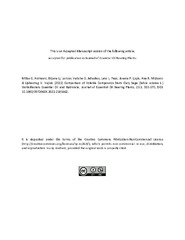Приказ основних података о документу
Comparison of volatile compounds from clary sage (Salvia sclarea L.) verticillasters essential oil and hydrolate
| dc.creator | Aćimović, Milica | |
| dc.creator | Lončar, Biljana | |
| dc.creator | Jeliazkov, Valtcho | |
| dc.creator | Pezo, Lato | |
| dc.creator | Ljujić, Jovana | |
| dc.creator | Miljković, Ana | |
| dc.creator | Vujisić, Ljubodrag | |
| dc.date.accessioned | 2022-08-12T07:28:32Z | |
| dc.date.available | 2023-08-08 | |
| dc.date.issued | 2022 | |
| dc.identifier.issn | 0972-060X | |
| dc.identifier.issn | 0976-5026 | |
| dc.identifier.uri | http://fiver.ifvcns.rs/handle/123456789/3020 | |
| dc.description.abstract | The volatile compounds of essential oil (EO) and corresponding hydrolate (HY) extracted by steam distillation from clary sage (Salvia sclarea L.) cv “Domaća mirisna” grown in Serbia were identified using gas hromatography/mass spectrometry (GC/MS). The most abundant compounds of EO were linalyl acetate (43.5%) and linalool (25.9%), followed by α-terpineol, germacrene D, and geranyl acetate. In the corresponding HY (recovered water-soluble fraction of EO) the dominant were linalool (63.3%) and α-terpineol (26.8%), followed by geraniol. These differences in composition between clary sage EO and HY could be explained by linalyl acetate's low water solubility. Clustering of 55 clary sage EO accessions (from literature) shows the presence of several chemotypes: linalyl acetate+linalool, linalyl acetate+sclareol, linalool+geranyl acetate, germacrene D+β-caryophyllene, caryophyllene oxide, and three unspecified chemotypes (geranyl acetate, methyl chavicol, and α-terpineol). According to this classification, clary sage cv “Domaća mirisna” belongs to a moderate linalyl acetate chemotype (between 19.8 and 45.7%). Further investigations need to focus on clary sage HY and their potential applications because HYs could increase economic gain as a by-product. However, their utilization for other purposes (cosmetic, postharvest fruit processing, organic agriculture, etc.) could be a safe solution for wastewater produced during EO distillation. | sr |
| dc.language.iso | en | sr |
| dc.publisher | Taylor & Francis | sr |
| dc.relation | info:eu-repo/grantAgreement/MESTD/inst-2020/200032/RS// | sr |
| dc.relation | info:eu-repo/grantAgreement/MESTD/inst-2020/200168/RS// | sr |
| dc.rights | embargoedAccess | sr |
| dc.rights.uri | https://creativecommons.org/licenses/by-nc/4.0/ | |
| dc.source | Journal of Essential Oil Bearing Plants | sr |
| dc.subject | volatile compounds | sr |
| dc.subject | hydrolate | sr |
| dc.subject | steam distillation | sr |
| dc.subject | chemotypes | sr |
| dc.subject | linalyl acetate | sr |
| dc.subject | linalool | sr |
| dc.subject | α-terpineol | sr |
| dc.subject | clary sage | sr |
| dc.subject | Salvia sclarea | sr |
| dc.subject | cultivars | sr |
| dc.subject | Domaća mirisna | sr |
| dc.subject | Serbia | sr |
| dc.title | Comparison of volatile compounds from clary sage (Salvia sclarea L.) verticillasters essential oil and hydrolate | sr |
| dc.type | article | sr |
| dc.rights.license | BY-NC | sr |
| dc.citation.epage | 570 | |
| dc.citation.issue | 3 | |
| dc.citation.rank | M22 | |
| dc.citation.spage | 555 | |
| dc.citation.volume | 25 | |
| dc.description.other | This is an Accepted Manuscript of an article published by Taylor & Francis in Journal of Essential Oil Bearing Plants on 08 Aug 2022, available at: [http://www.tandfonline.com/10.1080/0972060X.2022.2105662] | |
| dc.description.other | Published version in this repository [http://fiver.ifvcns.rs/handle/123456789/3019] | |
| dc.identifier.doi | 10.1080/0972060X.2022.2105662 | |
| dc.identifier.fulltext | http://fiver.ifvcns.rs/bitstream/id/8434/bitstream_8434.pdf | |
| dc.identifier.scopus | 2-s2.0-85135626672 | |
| dc.identifier.wos | 00083754580001 | |
| dc.type.version | acceptedVersion | sr |


